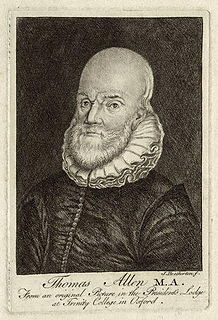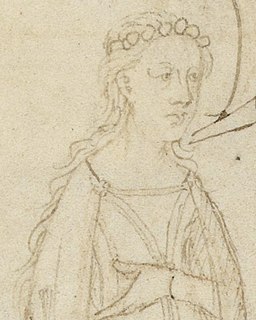Related Research Articles
Joan of Acre was an English princess, a daughter of Edward I of England and Eleanor of Castile. The name "Acre" derives from her birthplace in the Holy Land while her parents were on a crusade.

Edmund Mortimer, 5th Earl of March, 7th Earl of Ulster, was an English nobleman and a potential claimant to the throne of England. A great-great-grandson of King Edward III of England, he was heir presumptive to King Richard II of England when he was deposed in favour of Henry IV. Edmund Mortimer's claim to the throne was the basis of rebellions and plots against Henry IV and his son Henry V, and was later taken up by the House of York in the Wars of the Roses, though Mortimer himself was an important and loyal vassal of Henry V and Henry VI. Edmund was the last Earl of March of the Mortimer family.

Philippa of Clarence was a medieval English princess and the suo jure Countess of Ulster.

Gilbert de Clare, 6th Earl of Hertford, 7th Earl of Gloucester was a powerful English noble. He was also known as "Red" Gilbert de Clare or "The Red Earl", probably because of his hair colour or fiery temper in battle. He held the Lordship of Glamorgan which was one of the most powerful and wealthy of the Welsh Marcher Lordships as well as over 200 English manors.

The Keeper or Master of the Rolls and Records of the Chancery of England, known as the Master of the Rolls, is the President of the Civil Division of the Court of Appeal of England and Wales and Head of Civil Justice. As a judge, the Master of the Rolls is second in seniority in England and Wales only to the Lord Chief Justice. The position dates from at least 1286, although it is believed that the office probably existed earlier than that.

The House of Burgh or Burke was an ancient Anglo-Norman and later Hiberno-Norman aristocratic dynasty who held the earldoms of Kent, Ulster, Clanricarde, and Mayo at various times, provided one Queen Consort of Scotland, and played a prominent role in the Norman invasion of Ireland.
Constance of York, Countess of Gloucester was the only daughter of Edmund of Langley, 1st Duke of York, and his wife Isabella of Castile, daughter of King Peter of Castile and his favourite mistress, María de Padilla.

Thomas Allen was an English mathematician and astrologer. Highly reputed in his lifetime, he published little, but was an active private teacher of mathematics. He was also well connected in the English intellectual networks of the period.
John Giffard, Baron Giffard of Brimsfield (1232–1299) was an English nobleman prominent in the Second Barons' War and in Wales. His initial gift of land in Oxford led to the foundation of Gloucester College, Oxford.

Elizabeth de Berkeley, Countess of Warwick and Baroness Lisle, was an English noblewoman and heiress. She was the only child of Thomas de Berkeley, 5th Baron Berkeley, and Margaret de Lisle, 3rd Baroness Lisle.

The Lieutenant of the Tower of London serves directly under the Constable of the Tower. The office has been appointed at least since the 13th century. There were formerly many privileges, immunities and perquisites attached to the office. Like the Constable, the Lieutenant was usually appointed by letters patent, either for life or during the King's pleasure.

Justice of the Common Pleas was a puisne judicial position within the Court of Common Pleas of England and Wales, under the Chief Justice. The Common Pleas was the primary court of common law within England and Wales, dealing with "common" pleas. It was created out of the common law jurisdiction of the Exchequer of Pleas, with splits forming during the 1190s and the division becoming formal by the beginning of the 13th century. The court became a key part of the Westminster courts, along with the Exchequer of Pleas and the Court of King's Bench, but with the Writ of Quominus and the Statute of Westminster, both tried to extend their jurisdiction into the realm of common pleas. As a result, the courts jockeyed for power. In 1828 Henry Brougham, a Member of Parliament, complained in Parliament that as long as there were three courts unevenness was inevitable, saying that "It is not in the power of the courts, even if all were monopolies and other restrictions done away, to distribute business equally, as long as suitors are left free to choose their own tribunal", and that there would always be a favourite court, which would therefore attract the best lawyers and judges and entrench its position. The outcome was the Supreme Court of Judicature Act 1873, under which all the central courts were made part of a single Supreme Court of Judicature. Eventually the government created a High Court of Justice under Lord Coleridge by an Order in Council of 16 December 1880. At this point, the Common Pleas formally ceased to exist.
Mary MacDuff, Countess of Fife was an English noblewoman. She was a daughter of Ralph de Monthermer, 1st Baron Monthermer and his wife Joan of Acre. Other sources have her being born in 1298.
English county histories, in other words historical and topographical works concerned with individual ancient counties of England, were produced by antiquarians from the late 16th century onwards. The content was variable: most focused on recording the ownership of estates and the descent of lordships of manors, thus the genealogies of county families, heraldry and other antiquarian material. In the introduction to one typical early work of this style, The Antiquities of Warwickshire published in 1656, the author William Dugdale writes:
I offer unto you my noble countriemen, as the most proper persons to whom it can be presented wherein you will see very much of your worthy ancestors, to whose memory I have erected it as a monumentall pillar and to shew in what honour they lived in those flourishing ages past. In this kind, or not much different, have divers persons in forrein parts very learnedly written; some whereof I have noted in my preface: and I could wish that there were more that would adventure in the like manner for the rest of the counties of this nation, considering how acceptable those are, which others have already performed

Affreca de Courcy or Affrica Guðrøðardóttir was a late 12th-/early 13th century noblewoman. She was the daughter of Godred Olafsson, King of the Isles, a member of the Crovan dynasty. In the late 12th century she married John de Courcy. Affrica is noted for religious patronage in northern Ireland.
Iorwerth ab Owain was a Welsh prince of Gwynllŵg and Lord of Caerleon.
References
- ↑ "King Lear Character List". Spark Notes. Archived from the original on 11 September 2019. Retrieved 2 September 2020.
- ↑ "Robert, first earl of Gloucester". Oxford Dictionary of National Biography (online ed.). Oxford University Press. doi:10.1093/ref:odnb/23716.(Subscription or UK public library membership required.)
- ↑ Connolly, Sharon Bennett. "Isabella of Gloucester, the Lost Queen of England". History The Interesting Bits. Archived from the original on 5 December 2019. Retrieved 2 September 2020.
- ↑ "Clare, Gilbert de, fifth earl of Gloucester and fourth earl of Hertford". Oxford Dictionary of National Biography (online ed.). Oxford University Press. doi:10.1093/ref:odnb/5437.(Subscription or UK public library membership required.)
- ↑ "Clare, Richard de, sixth earl of Gloucester and fifth earl of Hertford". Oxford Dictionary of National Biography (online ed.). Oxford University Press. doi:10.1093/ref:odnb/5448.(Subscription or UK public library membership required.)
- ↑ "Clare, Gilbert de [called Gilbert the Red], seventh earl of Gloucester and sixth earl of Hertford". Oxford Dictionary of National Biography (online ed.). Oxford University Press. doi:10.1093/ref:odnb/5438.(Subscription or UK public library membership required.)
- ↑ "Clare, Gilbert de, eighth earl of Gloucester and seventh earl of Hertford". Oxford Dictionary of National Biography (online ed.). Oxford University Press. doi:10.1093/ref:odnb/5439.(Subscription or UK public library membership required.)
- ↑ "Monthermer, Ralph de, first Lord Monthermer". Oxford Dictionary of National Biography (online ed.). Oxford University Press. doi:10.1093/ref:odnb/19078.(Subscription or UK public library membership required.)
- ↑ "Audley, Hugh, earl of Gloucester". Oxford Dictionary of National Biography (online ed.). Oxford University Press. doi:10.1093/ref:odnb/37134.(Subscription or UK public library membership required.)